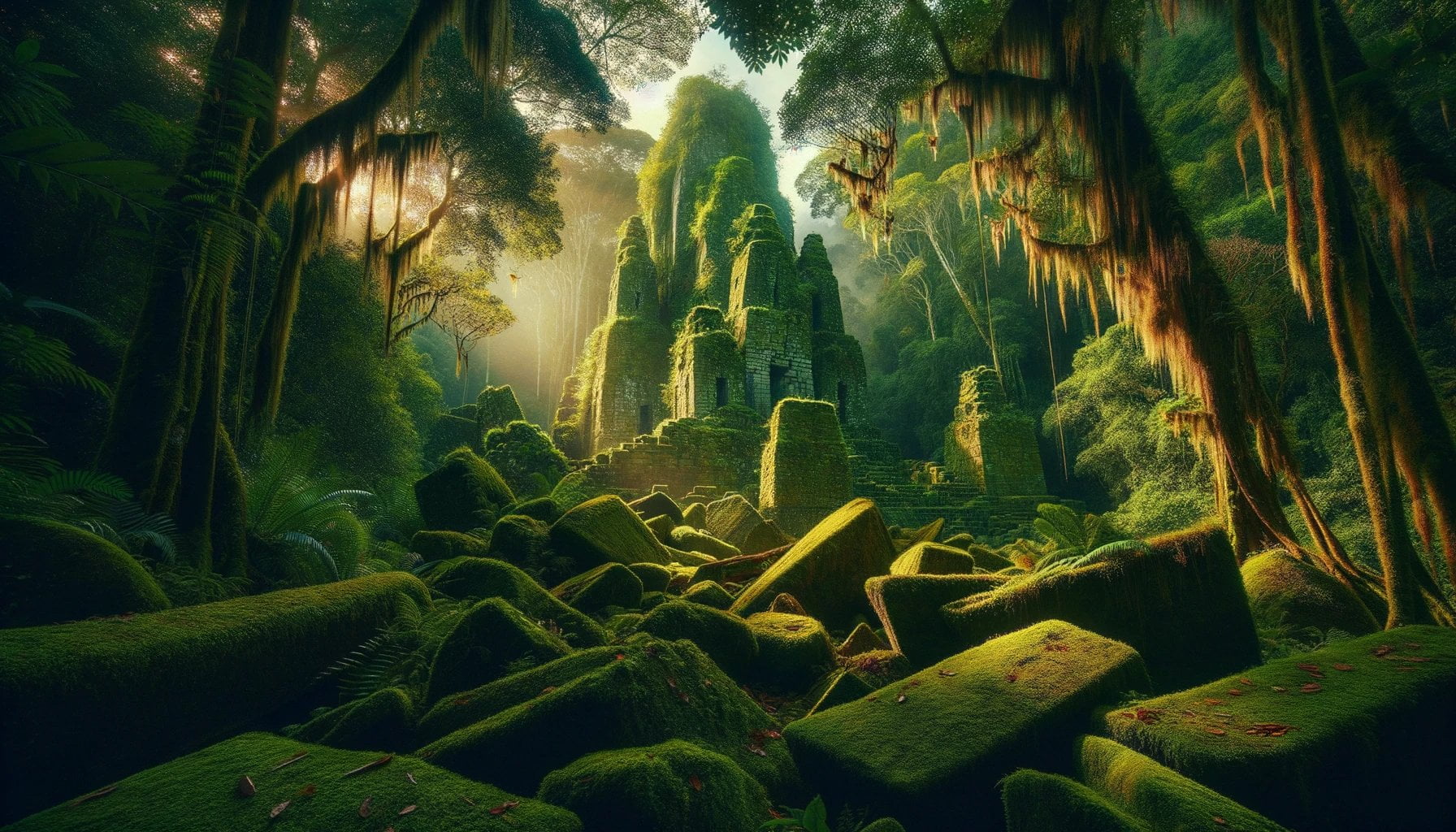Welcome to “Unveiling Brazil’s Ancient Ruins: A Journey through History.” In this captivating exploration, we delve into the enigmatic world of Brazil’s ancient ruins, where the echoes of a storied past still resonate through time. From the dense Amazon rainforest to the vibrant cities of Rio de Janeiro and Salvador, this article invites you on an incredible adventure, uncovering the hidden treasures and untold stories of Brazil’s rich cultural heritage. Join us as we embark on a mesmerizing journey through the architectural marvels and sprawling ruins of this captivating country, unraveling the mysteries that lie within.

Key Takeaways:
- Brazil has a rich history of ancient ruins, including cultural and natural sites.
- There are a total of 23 World Heritage Sites in Brazil, including cultural, natural, and mixed sites.
- The Historic Town of Ouro Preto was the first site in Brazil to be inscribed on the World Heritage list.
- Notable ancient ruins in Brazil include Sao Miguel das Missoes, Carandiru Prison Museum, National Historical Museum of Brazil, and the Ingá Stone.
- There are not many indigenous ruins in Brazil due to the nomadic nature of tribes and the use of materials that decompose over time.
- The Pyramids of Brazil on the Atlantic Coast are considered the oldest pyramids in the world, dating back more than 5,000 years.
- The National Historical Museum of Brazil in Rio de Janeiro showcases the country’s history.
- History Hit provides a comprehensive list of ancient ruins and historical landmarks in Brazil.
- Wikipedia offers more information on Brazil’s World Heritage Sites and their significance.
- Google Arts & Culture provides insights into Brazilian archaeology and indigenous heritage.
Brazil Ancient Ruins: Unearthing the Mysteries of the Past
Introduction:
Brazil, a country with a rich history and diverse cultural heritage, is home to a multitude of ancient ruins waiting to be explored. From imposing temples to enigmatic stone structures, these remnants of the past offer a glimpse into Brazil’s captivating history. In this article, we will embark on a journey through Brazil’s ancient ruins, delving into their significance, historical context, and the untold stories they hold.
The Enchanting State of Preservation
One of the intriguing aspects of Brazil’s ancient ruins is their varying states of preservation. Some sites have managed to withstand the test of time, standing proudly as testaments to the ingenuity of their builders. Sao Miguel das Missoes, a World Heritage Site, showcases the architectural prowess of the 18th-century Jesuit missions in the region. The intricately carved decorations and imposing stone structures transport visitors back to a time when these missions played a central role in the lives of indigenous communities.
However, not all ancient ruins in Brazil are perfectly preserved. The Carandiru Prison Museum in Sao Paulo serves as a haunting reminder of the country’s more recent history. While the prison itself no longer stands, the museum stands firm, imparting a somber and thought-provoking experience. Visitors can learn about the prison’s dark past and the stories of the inmates who once inhabited its walls, reflecting on themes of justice, human rights, and social change.
Exploring Brazil’s Cultural Gems
Brazil’s ancient ruins span a wide range of cultures and civilizations, each with its own unique story to tell. The National Historical Museum of Brazil in Rio de Janeiro serves as a treasure trove of artifacts and exhibits, offering a comprehensive insight into the country’s history. From ancient ceramics to documents from the colonial era, visitors can delve into the fascinating tapestry of Brazil’s past.
Venturing deeper into Brazil’s heartland, we encounter the enigmatic Ingá Stone. This striking geological formation, etched with intricate carvings, has puzzled archaeologists and historians for centuries. Some believe it to be a prehistoric astronomical observatory, while others propose that it holds ancient religious or mythical significance. Regardless of its true purpose, the Ingá Stone invites visitors to ponder the mysteries of Brazil’s ancient civilizations.
The True Ancient Marvels: Pyramids of Brazil
Hidden along the Atlantic coastline lie the Pyramids of Brazil, a true testament to the ingenuity and advanced engineering of Brazil’s ancient inhabitants. These pyramids, dating back over 5,000 years, predate even the famous pyramids of Egypt. Although not as grand in size, they are no less awe-inspiring. Each step taken towards unraveling their secrets is a step closer to understanding the origins of these ancient civilizations.
Conclusion
Immersing oneself in the ancient ruins of Brazil is like stepping into a time machine, transporting us to bygone eras and cultures. From the haunting remnants of prisons to the architectural marvels of missions, each site holds a unique place in Brazil’s historical tapestry. Whether exploring the well-preserved Sao Miguel das Missoes or contemplating the enigmatic Ingá Stone, these ancient ruins ignite our curiosity and deepen our understanding of Brazil’s captivating past. So, are you ready to uncover the secrets of Brazil’s ancient ruins and indulge in the mysteries they hold? The journey awaits.
If you’re fascinated by the mysteries of ancient civilizations, then you can’t miss exploring the captivating ancient ruins in Egypt. Discover the hidden wonders of the pharaohs and unravel the secrets of the pyramids. Click here to embark on an extraordinary journey through time.
Unearth the enchanting remnants of the Roman Empire with our ancient Roman trivia. Test your knowledge about the legendary gladiators, awe-inspiring architecture, and ingenious engineering. Delve into the past and challenge yourself by clicking here.
Step back in time and immerse yourself in the captivating history of Bolivia’s ancient ruins. Explore the fascinating remnants of ancient civilizations that once thrived in this breathtaking country. Embark on an adventure of a lifetime by clicking here.
Embark on a mesmerizing journey to the island of Malta and uncover its rich history through its ancient ruins. From megalithic temples to Roman catacombs, Malta offers a treasure trove of ancient wonders waiting to be explored. Click here to immerse yourself in the allure of Malta’s past.
The Architectural Marvels of Brazil’s Ancient Ruins
Ancient ruins hold a certain allure, captivating our imaginations as we step into the footsteps of those who came before us. Brazil, with its rich history and cultural heritage, is home to a fascinating array of ancient ruins that reveal the architectural marvels of civilizations past. From the well-preserved World Heritage Site of Sao Miguel das Missoes to the mysterious Ingá Stone, these ancient remnants provide a glimpse into Brazil’s captivating history. Join me on a journey through history as we unveil the architectural wonders of Brazil’s ancient ruins.
The Enigmatic Ingá Stone
One of Brazil’s most perplexing ancient ruins is the Ingá Stone. This geological formation, adorned with intricate carvings, raises questions about its purpose and significance in ancient civilizations. As we gaze upon the stone’s enigmatic carvings, we can’t help but wonder about the stories it holds and the people who left their mark on this geological wonder.
The Magnificence of Sao Miguel das Missoes
In the heart of Brazil lies the splendor of Sao Miguel das Missoes, a World Heritage Site that showcases the architectural skills of 18th-century Jesuit missions. As we wander through the well-preserved ruins, we witness the grandeur of the past, marveling at the intricate details and sheer magnitude of the buildings. Each stone tells a story, immersing us in Brazil’s rich cultural legacy.
Rediscovering Brazil’s Lost Pyramids
Hidden along the Atlantic coastline of Brazil, a hidden treasure awaits discovery – the Pyramids of Brazil. Dating back over 5,000 years, these ancient structures demonstrate advanced engineering skills and leave us in awe of the capabilities of past civilizations. As we explore these majestic pyramids, we are transported back in time, witnessing the ingenuity that shaped Brazil’s ancient landscapes.
The Resilient Carandiru Prison Museum
While not ancient in the traditional sense, the Carandiru Prison Museum in Sao Paulo stands as a poignant reminder of Brazil’s more recent history. Exploring themes of justice and human rights, this museum offers a unique perspective on the architectural heritage of Brazil. The walls whisper stories of the past, inviting us to reflect on the complexities of our society.
Key Takeaways:
- Brazil’s ancient ruins offer a glimpse into the country’s rich history and cultural heritage.
- The Ingá Stone’s intricate carvings invite speculation about its purpose and significance.
- Sao Miguel das Missoes showcases the architectural skills of 18th-century Jesuit missions.
- The Pyramids of Brazil demonstrate advanced engineering skills and date back over 5,000 years.
- The Carandiru Prison Museum explores themes of justice and human rights, serving as a reminder of Brazil’s recent history.
Sources:
– ResearchGate: Ruin and architectural heritage in Brazil: memory and oblivion
– Tripster Panda: Aztecs, Mayans or Incas In Brazil?
The Cultural Heritage of Brazil’s Ancient Ruins
As you venture into the heart of Brazil, a world steeped in history and cultural heritage awaits you. Follow me on a journey through time as we explore the ancient ruins that dot this captivating country.
Unearthing the Treasures: Brazil’s Ancient Ruins
The majestic ruins of Brazil serve as a testament to the rich cultural heritage of the region. From crumbling structures that whisper tales of forgotten civilizations to well-preserved sites that transport you back in time, each ruin has a story to tell.
Exploring Brazil’s Ancient Ruins: A Tapestry of History and Culture
1. A Glimpse into the Past: Significance and Historical Context
Brazil’s ancient ruins hold immense historical and cultural significance, providing a window into the civilizations that once thrived in this land. These architectural remnants are not just dilapidated structures but the very essence of a bygone era.
2. Archaeological Discoveries: Unraveling the Secrets
Through the meticulous efforts of archaeologists and researchers, we have gained invaluable insights into Brazil’s ancient ruins. Excavations have unearthed artifacts, artworks, and writings that shed light on the lives of the people who once inhabited these magnificent structures.
3. Conservation and Preservation: Safeguarding Brazil’s Heritage
Preservation policies in Brazil recognize the value of architectural remnants in a state of ruin as cultural assets. Efforts are underway to protect and restore these ancient ruins, ensuring that future generations can continue to experience their beauty and immerse themselves in the rich cultural tapestry of Brazil.
4. World Heritage Sites: Showcasing Brazil’s Cultural Gems
Brazil boasts an impressive list of 23 World Heritage Sites, both cultural and natural. These sites, recognized by UNESCO, exemplify Brazil’s exceptional cultural heritage and scenic beauty. From the iconic National Historical Museum in Rio de Janeiro to the awe-inspiring Serra da Capivara National Park, each site holds a unique place in Brazil’s ancient ruins narrative.
Key Takeaways:
- Brazil’s ancient ruins offer a glimpse into the country’s rich cultural heritage and historical legacy.
- Preservation policies in Brazil recognize the value of ruins as cultural assets, prompting conservation and restoration efforts.
- Brazil is home to 23 World Heritage Sites, including the remarkable National Historical Museum and Serra da Capivara National Park.
- Archaeological discoveries within these ruins have provided valuable insights into the lives of ancient civilizations.
- Through exploration and preservation, we can safeguard Brazil’s cultural heritage for future generations.
Sources:
– Wikipedia – List of World Heritage Sites in Brazil
– History Hit – Historic Sites in Brazil
Now, pack your imagination and embark on a journey through Brazil’s ancient ruins. Let the whispers of the past guide you as you uncover the cultural heritage that lies within these magnificent archaeological treasures.
The Current State of Preservation and Conservation Efforts for Brazil’s Ancient Ruins
As a seasoned travel writer and history enthusiast with a deep passion for Brazil’s ancient ruins, I have witnessed firsthand the importance of preserving and conserving these magnificent sites. In this article, we will delve into the current state of preservation and conservation efforts for Brazil’s ancient ruins, highlighting the challenges faced and the actions taken to safeguard these treasures for future generations.
The Significance of Preservation and Conservation Efforts
Preservation and conservation efforts for Brazil’s ancient ruins are crucial for several reasons. Firstly, these ruins provide valuable insights into the country’s rich cultural heritage and historical significance. They offer a window into the lives of the people who once inhabited these sites, allowing us to better understand their civilizations, traditions, and advancements. By preserving and conserving these ruins, we are preserving a tangible link to Brazil’s past and ensuring that these treasures continue to inspire and educate future generations.
The Challenges Faced
Preserving and conserving ancient ruins is not without its challenges. Brazil’s vast size and diverse ecosystems make it a complex task to manage and protect these sites effectively. Additionally, increasing urbanization, climate change, and natural disasters pose significant threats to the stability and integrity of these ancient structures. Lack of funding and resources further complicate the preservation efforts, making it essential to acknowledge and address these challenges in order to effectively protect Brazil’s ancient ruins.
Current Preservation and Conservation Efforts
Despite the obstacles, Brazil has made commendable efforts to preserve and conserve its ancient ruins. Let’s explore some of the key initiatives and strategies that are being implemented:
1. National Institute of Historic and Artistic Heritage (IPHAN)
The National Institute of Historic and Artistic Heritage (IPHAN) plays a vital role in the preservation and conservation of Brazil’s ancient ruins. Established in 1937, IPHAN is responsible for identifying, cataloging, and protecting cultural heritage sites throughout the country. It collaborates with local communities, experts, and government agencies to develop and implement preservation strategies, ensuring the safeguarding of Brazil’s ancient ruins.
2. Restoration and Conservation Projects
Brazil has initiated numerous restoration and conservation projects to revive and maintain its ancient ruins. These projects involve the use of advanced techniques and technologies to ensure the structural stability and preservation of the ruins. Skilled professionals, including archaeologists, architects, and conservators, work diligently to restore and conserve the intricate details and historical significance of these sites. These efforts encompass both preventive conservation measures and active restoration works.
3. Partnerships and International Collaboration
Recognizing the global importance of Brazil’s ancient ruins, the country actively seeks partnerships and international collaboration to support preservation and conservation efforts. Collaborative initiatives involve sharing knowledge, expertise, and resources with organizations, experts, and governments from around the world. Such partnerships enhance the capacity to protect these sites and promote sustainable tourism, ensuring that the preservation efforts are not limited to the borders of Brazil.
Key Takeaways:
- Preservation and conservation efforts for Brazil’s ancient ruins are crucial to protect the country’s cultural heritage and historical significance.
- Challenges such as urbanization, climate change, and lack of funding and resources pose threats to the stability and integrity of these ruins.
- The National Institute of Historic and Artistic Heritage (IPHAN) plays a vital role in the preservation and conservation of Brazil’s ancient ruins.
- Restoration and conservation projects employ advanced techniques and skilled professionals to revive and maintain the ancient ruins.
- Partnerships and international collaboration enhance the capacity to protect and preserve Brazil’s ancient ruins.
Sources:
1. Brazil’s conservation reform and the reduction of deforestation rates. (ResearchGate)
2. Committed to restoring tropical forests: an overview of Brazil’s restoration efforts. (IOPscience)

FAQ
Q1: What are some notable ancient ruins in Brazil?
A1: Some notable ancient ruins in Brazil include Sao Miguel das Missoes, Carandiru Prison Museum, National Historical Museum of Brazil, and the Ingá Stone.
Q2: How many World Heritage Sites does Brazil have?
A2: As of 2023, Brazil has a total of 23 World Heritage Sites, including fifteen cultural sites, seven natural sites, and one mixed site.
Q3: Are there many indigenous ruins in Brazil?
A3: No, there are not many indigenous ruins in Brazil due to the nomadic or semi-nomadic nature of the tribes and the use of materials like wood which decompose over time.
Q4: What are the oldest pyramids in the world located in Brazil?
A4: The Pyramids of Brazil, located on the Atlantic Coast, are considered the oldest pyramids in the world, dating back more than 5,000 years.
Q5: Where can I find a comprehensive list of ancient ruins and historical landmarks in Brazil?
A5: For a comprehensive list of ancient ruins and historical landmarks in Brazil, you can visit the website of History Hit.
- Unveiling Bernhard Caesar Einstein’s Scientific Achievements: A Legacy in Engineering - July 15, 2025
- Uncover who is Jerry McSorley: CEO, Family Man, Business Success Story - July 15, 2025
- Discover Bernhard Caesar Einstein’s Scientific Contributions: Unveiling a Legacy Beyond Einstein - July 15, 2025















